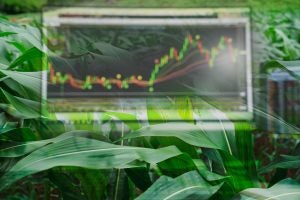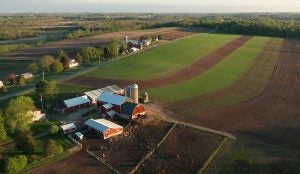With markets still in turmoil, war in Ukraine, and another year of unpredictable weather patterns, agricultural producers are knee deep in the 2022 growing season with mixed emotions. Market forecasters the world over predict a financial recession to commence yet this year. But they’re also calling for another record-busting year in terms of production and demand. Today’s farmers will someday tell their grandchildren how the Roaring ‘20s roared indeed.
Interesting times for sure. At the U.S. Department of Agriculture’s 2022 Agricultural Outlook Forum Program hosted earlier this year, officials noted this year’s forecasts call for exports to break $183.5 billion, an increase of more than $11.3 billion over 2021’s record-setting year. But those numbers are intertwined with the now-expired Phase One trade agreement with China, and that’s a big part of the uncertainty going forward.
So, what does it all lead to? Here are the Top 5 agricultural issues for 2022 and how they’ll impact producers around the globe:

1. All Things China
The Phase One trade agreement officially expired in 2021 and now comes the real fun as there was never any explanation of what a potential “Phase Two” might bring. Per the agreement, China agreed to purchase an additional $200 billion worth of U.S. products, including agricultural through 2021. Critics claim China never fully lived up to the deal while others tout it as victory. Irrespective of the partisan rancor, what comes next is a mystery as that nation may well continue to purchase at 2021 levels simply out of need. On April 4, China agreed to purchase 1.084 million tonnes of U.S. corn, with 676,000 to be delivered in the 2021-22 marketing year ending August 31, and 408,000 in 2022-23, according to the USDA.
But considering the toxic war in Ukraine under invasion by Russia, and the U.S. sanctions growing steeper, producers have good reason to wonder whether we’ll have a Phase Two and what future deals could be as China publicly states its intent to become less dependent on foreign grain going forward.

2. All Things Price
It appears to be another “good news, bad news” kind of year. As reported on May 26, July 2022 corn opened at $7.627 per bushel, with September corn at $7.30, and December $7.115. July soybeans opened at $16.75, with August at $16.15, and November at $15.08. Those are historic numbers for sure, unfortunately the cost of inputs has risen to match. With crude oil at $114 per barrel, diesel fuel is running north of $5.35 per gallon.
The USDA reports that just in the last year alone, the cost of urea is up 149 percent, liquid nitrogen up 192 percent, and anhydrous ammonia up 235 percent. And with supply chains still struggling to keep up from the COVID-19 pandemic, and the global supply of agricultural products from Ukraine and Russia in flux due to the wars, U.S. producers aren’t quite sure what to make of the mixed blessings of price.

3. The Economy
As 2022 heads towards its midpoint, inflation rules the day. The U.S. Bureau of Labor Statistics reported consumer prices up 8.5 percent, a continuation of the lingering inflation attributed to the COVID pandemic. Meanwhile, the Congressional Budget Office predicts that Federal Reserve moves with lending rates should cool that off over time. The CBO predicts a Real Gross Domestic Product (GDP) of 3.1 percent in 2022, 2.2 percent in 2023, and 1.5 percent in 2024. Inflation measured by Consumer Price Index is predicted to be 4.7 percent in 2022, 2.7 percent in 2023, and 2.3 percent in 2024. Meanwhile, the Federal Reserve prime rate is predicted to be 1.9 percent in 2022 and 2.6 percent by 2023.
That last component will undoubtedly affect every single element within the agricultural industry as lending is key to not only crop production and business operations, but the financing of equipment, which has become significantly pricier the last two years.

4. Farmland Values
Prices may vary across the country but as a whole, farmland prices have risen dramatically in recent years. According to the Purdue Farmland Values and Cash Rent Survey, 2021 saw top quality farmland prices in Indiana increase by 14.1 percent to $9,785 per acre. Even poor-quality land values increased by 12.1 percent to $6,441. Cash rental rates also increased in that state last year, up 3.9 percent for top quality ground to $269 per acre, and up 4.6 percent to $183 for even poor quality.
Grain is setting record prices for sure, but with the cost of inputs pacing it, the expectation of these farmland values continuing to rise at this rate is unrealistic when factoring in the increased cost of borrowing money going forward. If, as some forecasters are predicting, an economic crash or recession occurs in 2023 and these farmland values fall, landowners’ ability to borrow could significantly altered. The old adage is true: What goes up must come down. But no one really knows when.

5. Politics As Unusual
The year 2022 also brings with it a most contentious midterm election for the U.S. House of Representatives and Senate, not to mention state legislative seats around the country. The Democratic administration of President Joe Biden has taken a starkly different approach to agricultural policy than his predecessor, Republican Donald Trump, and the results of this November’s election could be just as impactful to farmers as their harvest that same month.
From the Farm Bill to all things trade policy, all things agricultural hinge on this election between two increasingly hostile parties. With a total of 435 House and 34 Senate seats up this year, political pundits predict a swing back to a Republican-dominated legislature and simply creates more uncertainty yet.
Interesting Times for Sure
There’s an old Chinese curse that wishes upon an enemy “that they live in interesting times.” The post-COVID environment is all that and a bag of chicken feed, for sure. Agricultural producers and suppliers alike are heading into 2022 after a rock‘em-sock’em kind of 2020 and 2021, looking to next year for perhaps more of the same.
But the world population continues to grow hungrier by the day, and there’s no doubt demand will be there. Farmers have survived interesting times before, and there’s little doubt they’ll live to tell the tale of the Roaring ‘20s to their grandkids.
Brian Boyce is an award-winning writer living on a farm in west-central Indiana. You can see more of his work at the Boyce Group homepage.



